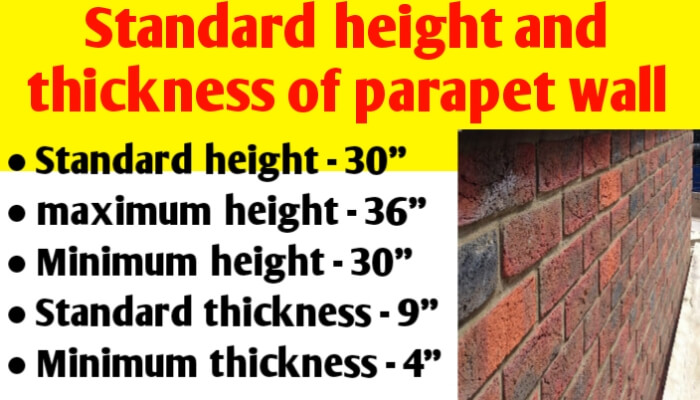The standard height of a parapet wall is typically around 3 feet (about 0.9 meters) for safety and aesthetics. However, building codes and local regulations may vary. The thickness of a parapet wall depends on factors such as structural considerations and architectural design. Generally, it can range from 6 inches to 12 inches (15 to 30 centimeters).
There is a need of parapet wall construction at the edge of roof, that preferably surrounding its perimeter. A parapet wall act as a barrier that is an extension of the wall at the edge of a roof, terrace, balcony, walkway or other structure.

What is parapet?
Parapet wall stands for a protection wall that can resist the collapsing from terrace to ground. Different types of parapet walls are found which range from brick wall masonry parapet wall, wooden handrail, iron grill etc.
◆You Can Follow me on Facebook and Subscribe our Youtube Channel
You should also visits:-
1)what is concrete and its types and properties
2) concrete quantity calculation for staircase and its formula
Define Parapet wall/ terrace wall/ walkway wall
Parapet may be simply portion of exterior wall that continues above the edge line of the roof. It is used to defend building from spread of Fire, to prevent people falling, and it provides additional support to roof.
Parapet may be plain, embattled, perforated or panelled, plain are upward extension of exterior wall, perforated parapet are available in various design such as circles, trefoils, or quaterfoils and ornamented by series of panels oblong square.
Parapet on Bridge and other Highway structure prevent user from falling off where there is drop. They may also meant to restrict views, to rubbish passing below and also act as noise barrier.
What is the purpose of a parapet wall
Providing parapet wall barrier above the exterior wall along the perimeter of roof. Their main purpose is, it protect and guard the building, house appear larger or increases the beauty of house, protecting the roof from collapsing or wind damage, to prevent the people from falling, prevent from moisture in roof, it is act as noise barrier and it prevent uplifting of roof.
Is parapet wall necessary
Yse, construction of parapet wall along the roof edge is necessary, it provide additional structural support to roof slab and preventing it from uplifting due to negative bending moment. It is also necessary to provide an aesthetic look to the structure, to provide safety for humans when they are on the rooftop, to hide and prevent the equipment and machinery on the rooftop.

Standard, minimum and maximum height of parapet wall
To prevent negative bending moment and uplifting of roof slab, providing a structural support to roof structure, the minimum height of parapet wall above roof surface should be 30 inches or 2.5 feet. This is normal, ideal, best, perfect and standard height of parapet wall construction along the edge of roof surrounding its perimeter.
The standard height of parapet wall is about 3 feet (36 inches, 1 meter, 100cm, or 1000mm) for full brick 9″ wall construction above the roof, along the edge of roof that surrounding its perimeter, and extension of exterior wall. It provide structural support to roof and prevent from uplifting.
In India, The standard height of parapet wall is about 3 feet (36 inches, 1 meter, 100cm, or 1000mm) for full brick 9″ wall above the roof and along the edge of roof that surrounding its perimeter.
The minimum height of parapet wall is about 2.5 feet (30 inches, 0.75 meters, 75cm, or 750mm) for full brick 9″ wall above the roof and along the edge of roof that surrounding its perimeter.
The maximum height of parapet wall is about 3.5 feet (42 inches, 1.25 meters, 125cm, or 1250mm) for full brick 9″ wall above the roof and along the edge of roof that surrounding its perimeter.
Standard thickness of parapet wall
The parapet wall should not be constructed less than 3 feet (36 inches, 1 meter, 100cm, or 1000mm) in height.
The typical minimum thickness of the parapet wall is 9 inches (or 230mm). This is normal, ideal, best, perfect and standard thickness of parapet wall construction along the edge of roof surrounding its perimeter.
To prevent from negative bending moment or uplifting of roof, for extending the first floor in future, to prevent from collapsing or wind damage, the minimum thickness of parapet wall should be 9 inches or 230mm.
To prevent negative bending moment, high amount of load acting on support that causes uplifting, half parapet wall or 4 inch thick wall cannot capture negative bending moment, therefore a different types of cracks at bottom of ceiling will be captured.
To get rid of uplifting of roof, the centring and shuttering should be eliminated once, the entire full brick parapet wall thickness of 9 inch constructed along the edge of roof surrounding its perimeter. Half brick parapet wall or 4 inch thick is not recommended for use.
Why minimum thickness of parapet wall should be 9 inch
Once the centering and shuttering from roof slab bottom is detached, some deflection may happen at mid span of roof slab (positive bending moment). Similar thing will happen at support like negative bending moment.
◆You Can Follow me on Facebook and
Subscribe our Youtube Channel
With a view to prevent negative bending moment at support, huge amount of loads are required as downwards. In case of constructing the parapet wall as half brick wall, the roof can’t be prevented from uplifting. If the parapet wall is constructed as minimum 9” thickness and minimum 3’0” height, the roof slab can be prevented from uplifting. Therefore, different types of cracks at bottom of ceiling will be captured. To get rid of uplifting of roof, the centering & shuttering should be eliminated once the entire full brick parapet wall is constructed.
If the first floor is extended in future, the existing parapet wall should not be dismantled in case the wall is constructed as 9” thick.
Assume, the parapet wall is constructed as half brick wall, now it is required to demolish the current parapet wall up to roof and make it as 9”, therefore, extra money will be incurred up to sill level of first floor.
While erecting half brick parapet wall, brick pillars should be arranged at regular interval ( 5 to 6 feet). Inner surface of parapet wall does not include flat surface since lots of offset will be created. Therefore, some problems will arise in waterline and sanitary plumping works.
Water from pump and discharge from water tank will be influenced with various offset produced with half brick parapet wall.
If the column height is terminated for the height of the parapet wall (3 feet), it is required to dismantle for overlapping in future first floor construction. Adjacent Brick parapet wall will also be affected. If the height of parapet wall remains 3 feet, the column height should be increased for extra height for future overlapping. Then the column and parapet wall will be protected from over damaged.
ALSO READ :-
Standard width of road | standard Road Lane width
Standard pitch of roof in degrees, ratio & fraction for house
Standard size of 1BHK, 2BHK, 3BHK & 4BHK flat in India
Standard size of stairs for residential & commercial building
Standard size of window for residential building
Conclusion:
It is recommended to construct full brick parapet wall is 9 inches thick and for minimum height of 2.5 feet devoid of half brick parapet wall. There should be some provision for column for future overlapping.